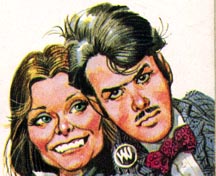The floorboards here in the executive suite of D.M.T. Plaza are layered with crumpled up heavy bond, much of it traced with blood and other DNA-carrying fluids. Is it the brutal heat of August? Is it the intoxicating whiff of desperation coming from Anne Coulter’s hairdo as Bush’s poll numbers dip? Perhaps we should explain.
 Sure, the endless torrent of spot-on social commentary and bleeding-edge critical perspective to which you have grown accustomed to synchronizing your cultural watches looks pretty damn easy to produce. And as jobs go, we suppose that this one is pretty cushy, what with the bratwurst bar and the foot rubs and all the mint toothpicks we can chew. But we must also point out that, some weeks, these instinctive calls that we are able to make on the disquieting-ness of up-to-the-minute social debris come a little less instinctively than others. And this week, fair readers, we are in a bit of a snit.1
Sure, the endless torrent of spot-on social commentary and bleeding-edge critical perspective to which you have grown accustomed to synchronizing your cultural watches looks pretty damn easy to produce. And as jobs go, we suppose that this one is pretty cushy, what with the bratwurst bar and the foot rubs and all the mint toothpicks we can chew. But we must also point out that, some weeks, these instinctive calls that we are able to make on the disquieting-ness of up-to-the-minute social debris come a little less instinctively than others. And this week, fair readers, we are in a bit of a snit.1
You see, part of being a jaundiced social critic—a withering smarty-pants who sees the worst is everything—is having an unlikely soft spot—like an overbearing Broadway critic who loves The Fantasticks, or Maureen Dowd’s unfulfilled carnal desire for Ari Fleischer. Dare we admit to our own tender underbellies, our own areas of shameless sentimentality, of inescapable bad taste and lowered critical standards?
Absolutely.
But what if our soft spots are in fact indefensible, even on shoddy “we know it’s lame, but at least we are owning up to how cheesy we are” sort of terms? As in, what if we are just out of the box wrong? And to create even more frisson: what if, before a specific artifact of pop culture, one of us were to fall in love and the other were to find, as it were, in favor of the prosecution? What if we were to … disagree?
Well, noble throng, it happens. Damn seldom, but it does. And this week, it did. It turns out one of us really thinks something is disquieting in the extreme, while the other wants to play his “aw, what the hell” chit and say it’s a sublime and beautiful thing. We are deadlocked. After days of e-mailed jeremiads, filled with the vitriol, baseless accusations, and poor spelling that the medium best accommodates, we are no closer to consensus than those two old dudes in good, if sweaty, suits at the end of Twelve Angry Men. We can’t work it out ourselves, and we are beginning to feel the icy breath of the deadline harpy on the backs of our necks.
So, we give up and fling the beast to the public. Comrades, behold below the object of our discontent, with arguments pro and con. We invite your perusal and careful weighing of the facts and encourage you to (gulp) tell us how you feel by dropping us an e-mail. We may share what you, the huddled masses, opine in a future edition, but make no commitments thereto. Think of your submissions as amicus briefs—the briefer the better.2
And no, that doesn’t mean we are finding our softer side or anything. We are just stymied. And so will you be too. And we also think the funniest thing ever published in The Onion back in the day was that “Point/Counterpoint” between the humidifier and the dehumidifier, which good luck finding it now on the site, you have to pay. But it is really funny.
Consider if you, will, Disquieting Modern Trends’ first ever bone of contention:
The Use of Sir Mix-a-Lot’s “Baby Got Back” in the Target TV Spot
Point:
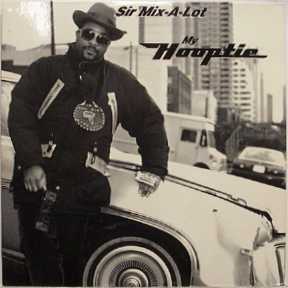 I hope that it goes without saying that we love Sir Mix-a-Lot and his catalog of populist hip-hop. “Baby Got Back,” his 1991 breakout hit and paean to the durable beauty and elemental appeal of the generously proportioned female hindquarters, can scarcely be improved upon as a hit single—catchy, funny, zeitgeist-capturing and possibly even zeitgeist-shaping in both its honesty and its reportage. This single alone would be enough to make Mr. Anthony Ray of Seattle, Washington, one of our favorite rap jokesters.3 One can only call it gravy on the fries that he preceded “B.G.B.” with a brilliant immortalizing of his tired ’69 Buick (“My Hooptie”4) and followed it with a track urging women to place their chests in car windows for his enjoyment.5 The “Baby Got Back” video was so rump-shakingly scandalous in it’s day that MTV agreed to play it only at night—so you can imagine the moms-guarding-America’s-virtue-style disquietude that greeted Target’s decision to use this song as the centerpiece of a back-to-school clothing advertisement featuring kids jumping around beneath cartoon clouds.
I hope that it goes without saying that we love Sir Mix-a-Lot and his catalog of populist hip-hop. “Baby Got Back,” his 1991 breakout hit and paean to the durable beauty and elemental appeal of the generously proportioned female hindquarters, can scarcely be improved upon as a hit single—catchy, funny, zeitgeist-capturing and possibly even zeitgeist-shaping in both its honesty and its reportage. This single alone would be enough to make Mr. Anthony Ray of Seattle, Washington, one of our favorite rap jokesters.3 One can only call it gravy on the fries that he preceded “B.G.B.” with a brilliant immortalizing of his tired ’69 Buick (“My Hooptie”4) and followed it with a track urging women to place their chests in car windows for his enjoyment.5 The “Baby Got Back” video was so rump-shakingly scandalous in it’s day that MTV agreed to play it only at night—so you can imagine the moms-guarding-America’s-virtue-style disquietude that greeted Target’s decision to use this song as the centerpiece of a back-to-school clothing advertisement featuring kids jumping around beneath cartoon clouds.
 We should find this disquieting too, but for a different reason. We are on the record as being staunchly pro-ass-songs-in-ads-featuring-kids, but we are typically against the appropriation of cool art for commercial purposes. When John Lennon’s “Imagine” was used in a 1996 American Express ad, for example, we pretty much looked Western culture in the eye and said, “Check, please.” And my partner will no doubt suggest that the Sir-Mix Target ads fall into this category—being not merely the appropriation of glorious cultural artifact for the purpose of selling cheap crap but also a grossly premature use of a relatively recent song as nostalgic kitsch. As to the latter argument, folks: the horse is long gone, so don’t mind the barn doors. Kids these days refer to that Nelly song “Hot in Herrre” as “old-school,” and I’ve little doubt it’s being used in an air conditioner ad somewhere already. The voracious nostalgia machine is already swallowing its own tale. It’s too late.
We should find this disquieting too, but for a different reason. We are on the record as being staunchly pro-ass-songs-in-ads-featuring-kids, but we are typically against the appropriation of cool art for commercial purposes. When John Lennon’s “Imagine” was used in a 1996 American Express ad, for example, we pretty much looked Western culture in the eye and said, “Check, please.” And my partner will no doubt suggest that the Sir-Mix Target ads fall into this category—being not merely the appropriation of glorious cultural artifact for the purpose of selling cheap crap but also a grossly premature use of a relatively recent song as nostalgic kitsch. As to the latter argument, folks: the horse is long gone, so don’t mind the barn doors. Kids these days refer to that Nelly song “Hot in Herrre” as “old-school,” and I’ve little doubt it’s being used in an air conditioner ad somewhere already. The voracious nostalgia machine is already swallowing its own tale. It’s too late.
As to the former argument—the argument that the transformation of “Baby Got Back” into “We Like Back … Packs”6 is a sad dilution of a formerly subversive statement into inoffensive ad copy—I can only say: watch the ad.7 It is neither disturbing nor disappointing but, rather, just wonderful in every possible way. I love knowing that the syncopated rhythm of “B.G.B.” is now streaming into the average American ear on a regular basis, growing more and deeper funk furrows in our collective cerebral cortex, resulting in the eventual development of hyper-intelligence for us and our children, all from merely watching TV. I love the notion that red state mothers with W.W.J.D. magnets all over their fridge are being unknowingly seduced into buying more denim by a groove originally designed to celebrate the derrière. I love the explosion of tribal syncopation that the ad starts with, regardless of how the lyrics have been raped, because the song was always about rhythm in the first place, and kids that dig the ad are increasingly likely to find stuff like Coldplay antiseptically inadequate to their God-given need for the funk. In short, “Baby Got Back … Packs” is on a par with the polio vaccine. Disquietude be damned.
Counterpoint:
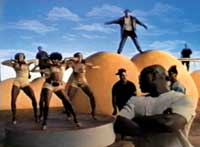 My esteemed colleague is clearly drunk with power (he is a C-List Blogebrity, y’all better recognize8), self-satisfaction, and Diet Pepsi.9
My esteemed colleague is clearly drunk with power (he is a C-List Blogebrity, y’all better recognize8), self-satisfaction, and Diet Pepsi.9
“Baby Got Back … Packs” is only the next, slightly lower step on the long and winding road to the abandonment of all separation between straightforward selling and invocation of nostalgia in the name of making a buck. Old Navy is primarily responsible for this; those ghastly commercials with Morgan Fairchild and that sheepdog that are shot to look like a Gilligan’s Island–era sitcom with all the cheery cluelessness intact, delivered without so much as a wink or knowing nod to orient the hapless adolescent viewer to what is really going on. Apparently the kids like this sort of thing, else they wouldn’t keep doing it. But what it really boils down to is the gelding of all past pop culture product of any of its import other than its kitsch value—because it’s old—which then means that the only thing that can be regarded genuinely is the new thing. And since the new thing is generally, more and more, the old thing, only macked out to sell Old Navy, well the whole thing is just a Möbius strip that eats its tail, pardon a violently mixed metaphor.
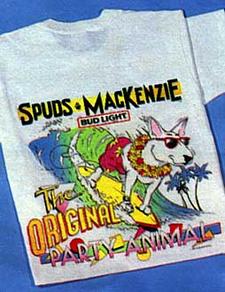 And so “Baby Got Back … Packs” should raise hackles primarily because it is collapsing the event horizon of what constitutes “old enough to be kitschy” to like atomic levels, what with Mix’s tune being really only like 10 years old tops. I Heart the 90’s is not yet fair game. Point of order: we need at least a decade before feeling nostalgia for something, because if we do it any sooner then history will not have decided which particularly ephemeral artifact to choose and elevate and we may inadvertently pay homage to the wrong thing (e.g., what if Spuds Mackenzie had been lionized to the level of the little Madonna plastic bracelet? As a decoupled signifier, the bracelet is infinitely more robust for 21st-century bricolage than is the surfing bull terrier. Dodged that bullet, eh? You’re welcome.)
And so “Baby Got Back … Packs” should raise hackles primarily because it is collapsing the event horizon of what constitutes “old enough to be kitschy” to like atomic levels, what with Mix’s tune being really only like 10 years old tops. I Heart the 90’s is not yet fair game. Point of order: we need at least a decade before feeling nostalgia for something, because if we do it any sooner then history will not have decided which particularly ephemeral artifact to choose and elevate and we may inadvertently pay homage to the wrong thing (e.g., what if Spuds Mackenzie had been lionized to the level of the little Madonna plastic bracelet? As a decoupled signifier, the bracelet is infinitely more robust for 21st-century bricolage than is the surfing bull terrier. Dodged that bullet, eh? You’re welcome.)
And it is particularly because we love the original that we wish to defend it against wholesale coöption at this early date. If history finds this tune to be a mighty anthem of its age, then glory be! Have at it! But if it is destined only to be the “Come On, Eileen” of the early 90s, then let’s give it a break for a while so we can be pleasantly surprised to find it anthologized on Megahits 49 or whatever in 2012. After all it has done for us, we owe it that, at least.
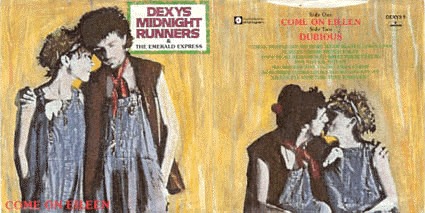
Finally, I suppose my esteemed colleague thinks he scooped my argument because he wrote his opening volley after reading my response, such is the hypertext non-linear narrative arc we describe. So, seeing the merits of my perspective wane before the blinding flash of his post-preëmptive strike, I would just like to add that he is also a wanker who still wears the Underoos his mommy bought him for his thirteenth birthday.10
So yo, man—what’s your story? We are exhausted and going to the bathhouse for a nice long schvitz and an egg cream. Please, send us your take. Who’s right on this one? Just leave a message, maybe we’ll give you a ring or, like, show up at your door for some tuna.

